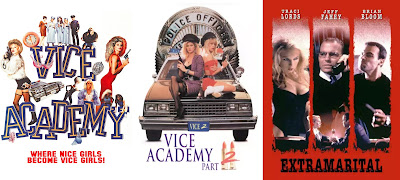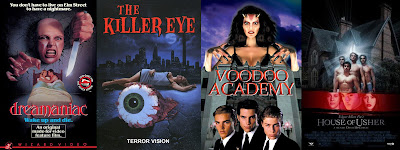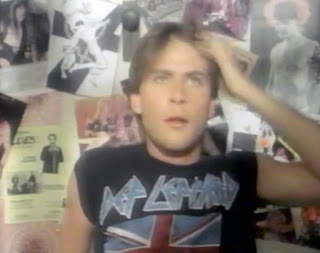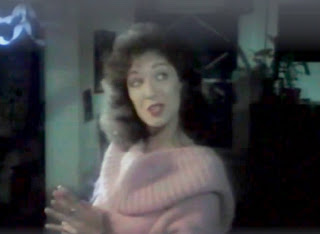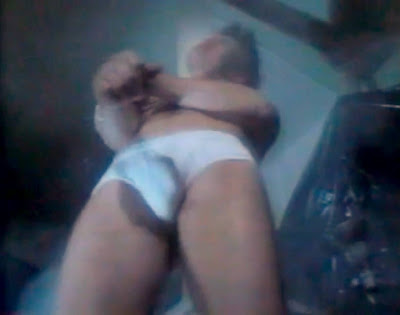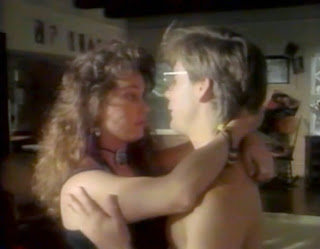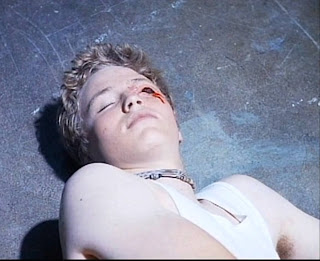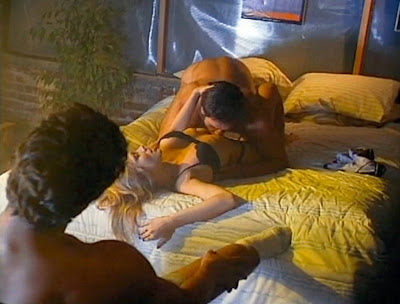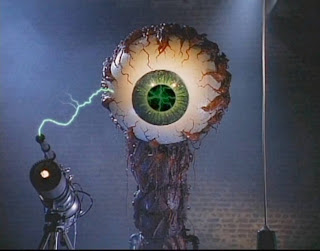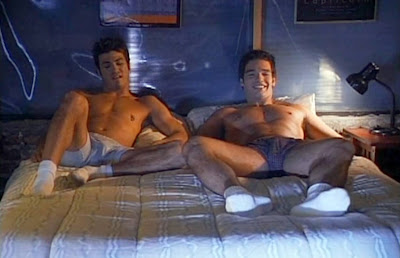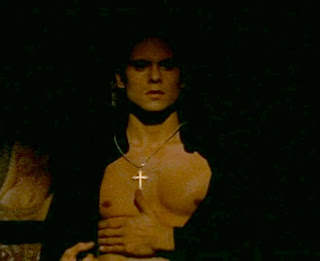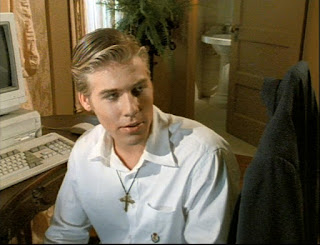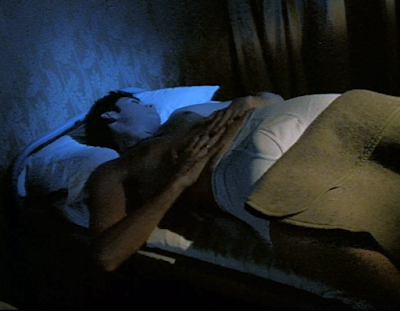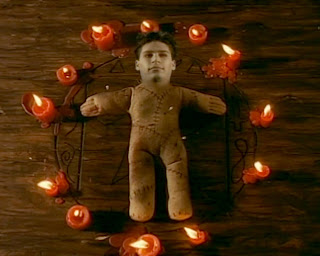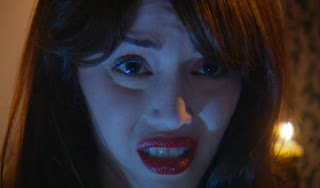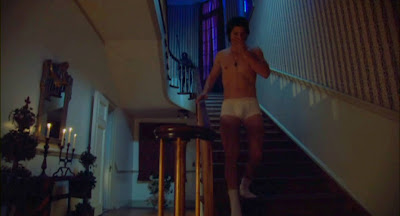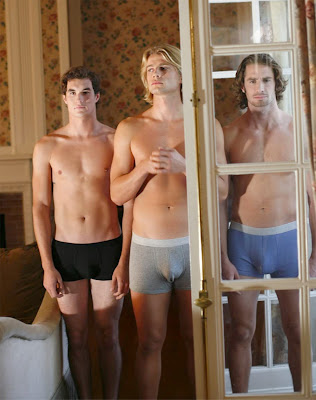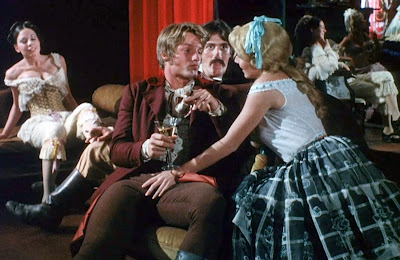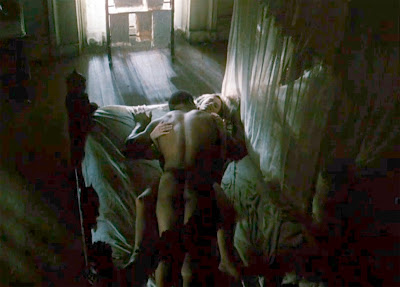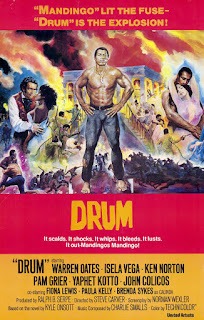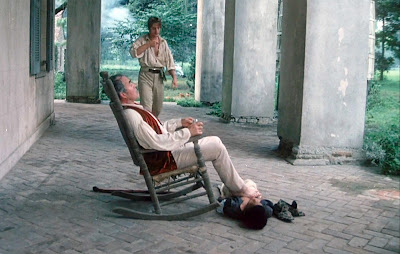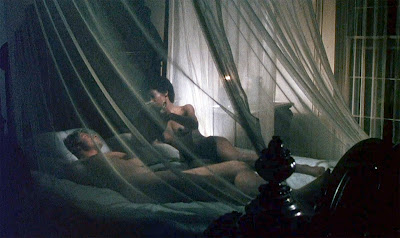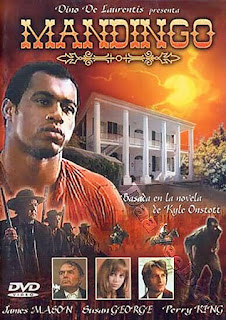“Ginger, do you really think they’re going to give you an Oscar? You suck cock for a living, for God’s sake!”
— Amber Lynn, reacting to Ginger Lynn’s
decision to pursue a mainstream acting career
The above quote came from the podcast Once Upon a Time in the Valley, which, besides revealing Amber Lynn as a surprising voice of reason, sought to uncover the mysteries behind the Traci Lords scandal. Though the podcast ultimately generates as many questions as it answers, it’s still worth a listen.
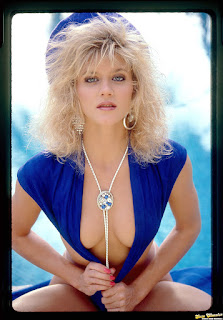 |
| 1980s-era Ginger Lynn, photographed by Suze Randall |
Still, as long as they make peace with the fact that they’ll never be awarded a gold statuette or know the respect attendant to reality show fame, porn stars can transition to mainstream careers. Inspired by the Once Upon a Time in the Valley podcast, I thought I’d take a look at a couple of the legit movies made by Ginger Lynn and Traci Lords, two of the biggest porn stars of the 1980s and fierce rivals (seriously, Ginger hates Traci), and see if they have the talent and star power to carry a film without sucking any cock (or doing DPs, or anal, or girl-on-girl...).
Right off the bat, I’ll say Ginger Lynn is at a disadvantage. While she has been in some bigger mainstream movies like Young Guns II and The Devil’s Rejects, those roles were too small to provide much of an impression. Also, I fucking HATED The Devil’s Rejects and have no intention of watching it again, ever. How much did I hate it? At least as much as Ginger hates Traci. I hated it so much that I watched two VICE ACADEMY movies instead.
The Vice Academy franchise is the brainchild of writer-director Rick Sloane, the man behind Hobgoblins. Suffice it to say, these movies aren’t exactly going to launch anyone’s career. If anything, the Vice Academy movies are the kind of cinematic dross that leads actors to give up on their Hollywood dreams and just do porn, so I really have to wonder what Ginger Lynn was hoping to achieve by appearing in them. Maybe she just welcomed the opportunity to appear in movies that didn’t require her to fuck Ron Jeremy, which, fair enough.
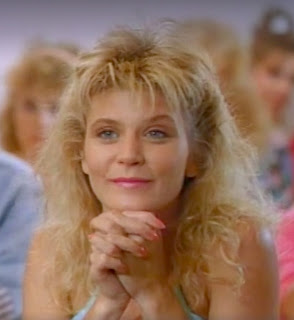 |
| Ginger Lynn begins to wonder if maybe Amber had a point. |
VICE ACADEMY (1989) is terrible, but it is better than Hobgoblins, if only because its campy sensibility comes off as intentional rather than a byproduct of incompetence. In this Z-grade Police Academy rip-off, Ginger, using her serious actress moniker Ginger Lynn Allen, plays Holly, the stuck-up daughter of the police chief and the top of her class in the titular vice academy (mitigating factor: the combined I.Q. of all the characters in Vice Academy is 35.) Holly’s adversary is DiDi (scream queen Linnea Quigley, squawking all her lines), who, along with friends Shawnee (busty Karen Russell) and Dwayne (Ken Abraham), a character whose sole reason for existence is a repeated nut shot joke, is among the worst students in the class. In a twist, DiDi is the horny one while Holly is Miss Goody-Two-Shoes, though she dresses only slightly more modestly than DiDi. This twist means that it’s DiDi who goes undercover to bust a porno ring and later a prostitution ring. BTW, it also means Quigley is the one showing any skin. You want to see Ginger naked, watch a Ginger Lynn video. Ginger Lynn Allen is above such crass exploitation—for now, at least.
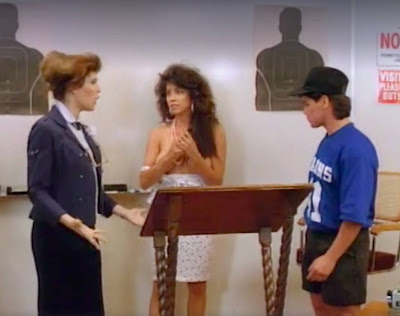 |
| Karen Russell (center) provides half the gratuitous nudity in Vice Academy. |
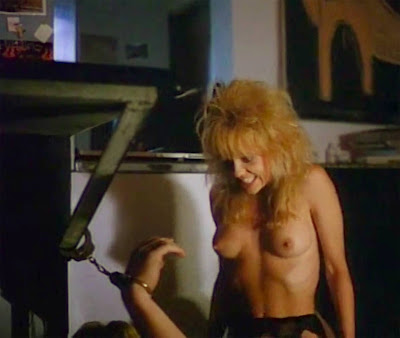 |
| Linnea Quigley provides the other half, her breasts taking priority over including her scene partner, Steven Steward, in the shot. |
Ginger Lynn Allen isn’t in Vice Academy to do much of anything, it turns out. With the bulk of the movie devoted to DiDi’s undercover work, Vice Academy is more Quigley’s movie than Ginger Lynn’s. The few scenes featuring the leads together are often commandeered by Jayne Hamil, who cranks it up to eleven in the role vice academy instructor Miss Devonshire. The scenes not overpowered by Hamil are handily stolen by Russell and, in the role of criminal mastermind Queen Bee, Jeannie Carol — or, more accurately, Carol’s wig. Ginger Lynn gets left on the sidelines.
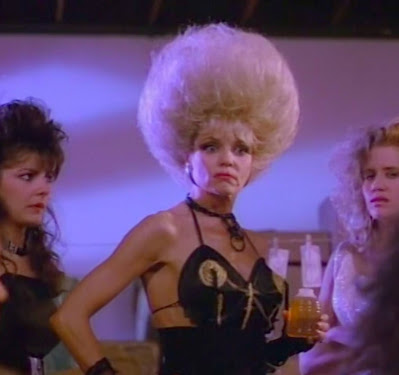 |
| No one can upstage Jean Carol’s wig in Vice Academy. |
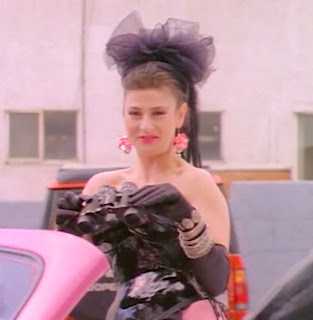 |
| Marina Benvenga is a slightly less awesome villain in Vice Academy Part 2. |
When Holly and DiDi fail, the LAPD implements its newest weapon: BimboCop (Teagan Clive, of Alienator, um, fame?). BimboCop’s first assignment? Switchboard duty, proving herself to be more competent than the current dispatcher, Jeannie (Jo Brewer), who spends more time making dates with horny truckers and satisfying the sexual demands of Officer Petrolino (Scott Layne) than doing her job. Determined to show their worth to the vice squad, Holly and DiDi return to Vicerama, this time under the guise of being strip-o-gram dancers, ensuring gratuitous nudity from Quigley and Ginger Lynn. But they’re cover is soon blown, as is Miss Devonshire’s when she shows up to fill the bookkeeper job, and Petrolino’s when he just shows up. It’s up to BimboCop to save the day. Too bad Jeannie has sabotaged BimboCop’s programming (that’s what happens when you include an easily accessible “worthless” setting). Can Spanish Fly be stopped? Can the Vice Accdemy series? Rick Sloane kept on making these things, ending with Vice Academy Part 6 in 1998. I chose to stop at Part 2.
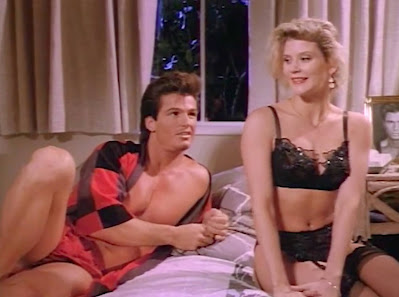 |
| Holly braces herself for a night of #MeToo with Officer Petrolino. |
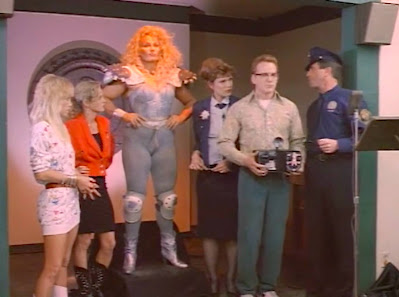 |
| Introducing BimboCop (groan). |
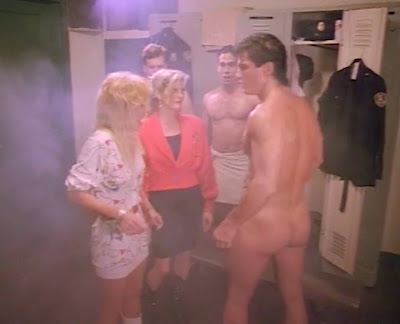 |
| It’s not just the women providing the gratuitous nudity this time around. |
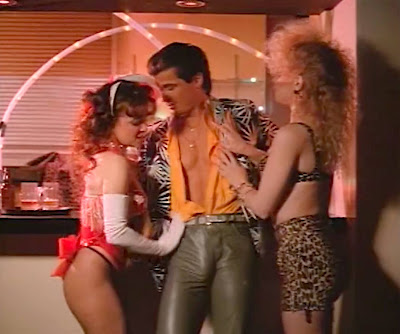 |
| That may not be a cucumber in his pants. |
Vice Academy Part 2 has slightly higher production values (it features a real police car!) and a lot more skin (in addition to Quigley and Ginger Lynn, Toni Alessandrini, as Vicerama stripper Aphrodite, and future Playgirl model Layne do their parts to increase the movie’s flesh quotient), but Vice Academy has more laughs. These are movies to watch with bong in hand.
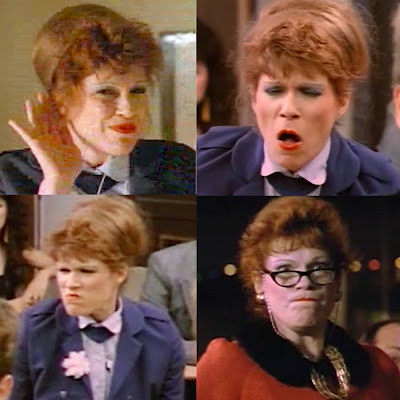 |
| The many faces of Jayne Hamil. |
But how to judge Ginger Lynn’s acting ability in movies where no one gives a real performance? I’ll say that while neither Quigley nor Ginger Lynn are particularly good, they do work well as a duo, and that Ginger Lynn doesn’t stand out as egregiously terrible. But no one should really have their talent judged on their performance in a Rick Sloane movie. Ginger Lynn did get positive notices for her star turn in Bound & Gagged: A Love Story, a 1993 indie comedy co-starring Chris Mulkey and Karen Black, though the movie itself is reportedly painful to sit through. It’s also not yet available for streaming. Ginger Lynn made enough of an impression to be considered for the female lead in Martin Scorsese’s Casino, but the studio wanted Sharon Stone for the role — at least, according to Ginger Lynn’s IMDb bio; the Casino IMDb page reports that a different ex-porn star was considered for the part.
From Scandal to the C-List
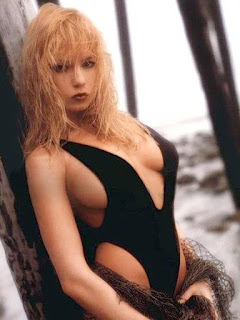 |
| Traci Lords, 1980s |
(One of the theories put forth in the Once Upon a Time in the Valley podcast is that Lords’ underage porn career was part of a long con; that she intended from the beginning to report her underage status when the time was right and escape the porn business as a “survivor.” It’s an interesting theory that I don’t entirely dismiss. I certainly don’t believe Lords was an innocent teen exploited by the industry, as she reportedly portrays herself in her 2004 autobiography, but I doubt she had formed this Machiavellian scheme when she first started as a nude model.)
Lords never made the A-list, but she’s done OK on the C-list, kicking off her mainstream career by starring in the 1988 remake of Not of This Earth, directed by schlockteur Jim Wynorski, but getting even more attention for appearing in John Waters’ 1990 comedy, Cry-Baby. There were guest appearances on Married…with Children, Melrose Place, and Roseanne, as well as a role in the TV mini-series The Tommyknockers. She even released an album, 1,000 Fires, in 1995. But most of her Hollywood career has been spent starring in direct-to-video fare. Among those DTV movies was EXTRAMARITAL (1998).
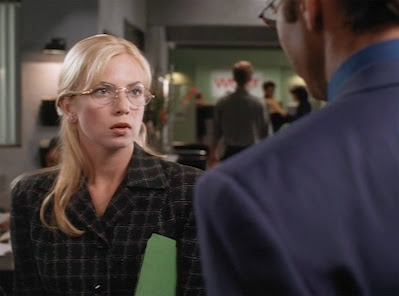 |
| Traci Lords: Journalist. |
Lords plays Elizabeth, an aspiring journalist (just go with it) interning at We@r magazine, where she must endure her editor Griff (Jeff Fahey, showing off what he learned in the Kevin Spacey School for Portraying Sleazy Southerners) belittling her at every turn. Elizabeth — who sometimes goes by Beth, sometimes Lizzy — is married to Eric (Jack Kerrigan, looking like an alcoholic Mark Ruffalo), who is not altogether supportive of Lizzy/Beth pursuing her dreams, especially since she gave up a high-paying job to do so, jeopardizing their chances of getting a loan to finish renovations on their L.A. home. Nevertheless, Eric takes Elizabeth to the airport so she can fly to San Francisco to interview “a city big-wig who’s been implicated in a huge sex scandal.”
On her flight Elizabeth meets Ann (statuesque Marìa Dìaz), traveling from her Malibu home to Napa Valley where she and her husband have a ranch. The two women later bump into each other in San Francisco when they discover they’re staying at the same hotel. What are the odds? Ann is accompanied by Bob (child actor-turned-hot cub Brian Bloom), who is most definitely not her husband. And just to make doubly sure that Elizabeth understands that Bob is her side piece, Ann and Bob get the foreplay started in full view of the reporter before they’ve even opened the door to their room, which is, in yet another coincidence, right next door to Elizabeth’s.
Though mystified by Ann’s unapologetic adultery, Elizabeth is also fascinated. Isn’t it convenient that We@r magazine is doing a sex issue, allowing Elizabeth to use Ann as a source? Ann is positively eager to answer the budding reporter’s questions. When Ann isn’t telling Elizabeth about her extramarital activities, she’s showing the audience, meeting Bob at an apartment for some afternoon sexy time. It’s during this encounter that we learn Ann likes to videotape their trysts and Bob likes to spice things up, paradoxically, by wearing a cunnilingus-impairing rubber mask that makes their sex scene look like a Halloween porn parody.
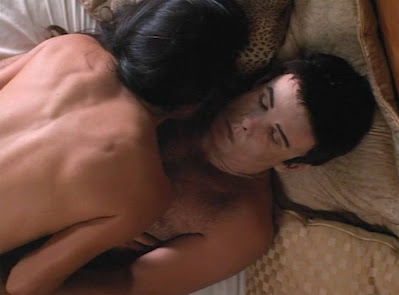 |
| The mask is supposed to be of Ann’s favorite actor, so... Ray Liotta after suffering a debilitating stroke? |
Is this sudden introduction of videotapes and Michael Myers cosplay really just a shoe-horned in plot-device? You bet your cheap champagne and lace thong it is! As is Ann’s calling Elizabeth so the reporter’s answering machine can record Ann getting plowed by her masked lover (as one does). But, oops, instead of a hot cock Ann gets penetrated by the cold steel of a knife, repeatedly.
Even if is the first erotic thriller you’ve ever seen, it should be no surprise that all of these coincidences aren’t that coincidental, that Elizabeth is being used, and that Bob is being set up, but by whom? Well, rest assured, Elizabeth will figure it out, right after she samples some of Bob’s lovin’ for herself.
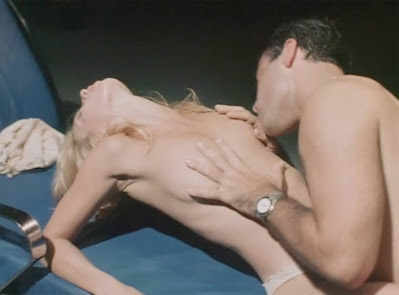 |
| Serious actresses don’t show their nipples. |
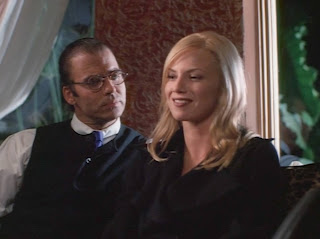 |
| “I’m not laughing at you, Jeff, I’m laughing ... OK, you got me. I’m laughing at you.” |
Extramarital was released by PM Entertainment, so it goes without saying that it’s not very good. It does more closely resemble a professionally made(-for-TV) feature than the Vice Academy movies, but that doesn’t necessarily mean Extramarital is better, just more polished. Screenwriter Don O’Melveny’s story is a bit of a mess, implying that Ann was somehow complicit in setting up her own murder, and it never quite clears one of the potential suspects. Jeff Fahey, the actor you call when Eric Roberts is busy, gives the movie a needed injection of camp, but not enough to boost the Extramarital’s entertainment value.
As for Lords, she’s fine. She holds her own against the talents of Fahey and Bloom, and she’s Meryl Streep in comparison to Dìaz, who delivers all her lines as if she’s dubbing a Doris Wishman movie. But while Lords’ is a competent actor, she isn’t a very compelling one. It’s not surprising that the bulk of her acting work has been confined to the small screen; she just doesn’t have a movie star’s magnetism. She’s got sex appeal, but Extramarital, and likely Lords herself (she’s credited as an executive producer), has little interest in playing that up. I get it, she’s playing against type and, you know, trying to distance herself from her porn notoriety, but this is an erotic thriller, so the audience can’t be faulted for having certain expectations. Alas, there are Lifetime TV movies that have hotter sex scenes than those featured in Extramarital.
Final verdict? Lords is the better actress in her bad movie, but Ginger Lynn is a lot more fun in hers.
Despite Lords’ assertion, per her IMDb bio, that she still bears the stigma of her porn years, she continued to be cast in TV shows (Profiler, First Wave) and movies (Blade, Zack and Miri Make a Porno). Ginger Lynn, who wholeheartedly owned her porn stardom, never gained much traction as a mainstream actor. Her TV roles were sporadic (guest appearances on NYPD Blue and Silk Stalkings) and her mainstream movies were mostly direct-to-video dreck like The Stranger. Predictably, Ginger Lynn returned to porn in 1999. Today, both women’s careers face a far bigger roadblock in Hollywood than their involvement in the porn industry: getting old.

